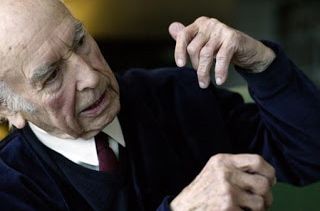 |
| Albert Hofmann |
“High” on LSD doesn’t quite cover it.
The hallucinogenic drug provided such a mind-altering experience that almost all users of the 1960s swore off the stuff, sooner or later.
Mostly sooner.
As a social phenomenon (and widespread social problem), LSD’s run lasted only a few twisted years in the 1960s. But its influence lingers, like some never-ending flashback.
Martin Witz’s splendid documentary “The Substance: Albert Hofmann’s LSD” artfully incorporates archival footage, new interviews and clips from anti-drug propaganda films - feeling at times more like a science fiction film than documentary.
It tracks the bizarre drug from its first synthesis in a Swiss laboratory in 1948 to modern-day efforts to use it in treatment of people with terminal illnesses.
Icarius Films has released the 90-minute “The Substance” on DVD. It includes a 27-minute interview with filmmaker Witz shot at a German film festival. Audio and video are good enough.
The Swiss documentarian said he took on the project after wondering why no one from his nation had tackled the story of chemist Albert Hofmann (pictured) and his “slightly strange Swiss export.”
“This substance traveled all over the globe, causing massive upheaval,” Witz says. Yet, before long “it disappeared completely.”
Neither permissive nor judgmental in approach, Witz nevertheless found himself a target of critics who said his film was championing the drug (he says he’s tripped, but was never a member of the “esoteric community” of habitual LSD users).
Witz pursued Hofmann, who lived in relative seclusion at age 102, finally arranging an interview. Hofmann died the day they were to talk. “The Substance” therefore relies on a satisfying interview filmed in 2008, shortly before the chemist turned 100.
Of the thoughtful Hofmann, Witz says, “he had the class to pay attention” to what he had wrought. He was not “a guru or a holy man.”
Hofmann says in the film, “I think that a chemist who is not a mystic is not a real chemist.” There are clips of Hofmann journeying deep into Mexico, sharing his LSD with a tribe of Indians whose religious rituals involved natural psychedelics. No one seemed to notice a difference.
Hofmann said he never thought LSD would hit the streets. He wrote U.S. professor Timothy Leary - of “turn on, tune in, drop out” fame - accusing him of forcing LSD on young people by advocating its use.
LSD remained an untested drug, Hofmann told Leary, and its startling experiences required “a certain maturity” to handle. A characteristic in short supply in the hippie culture of the late 1960s.
Leary emerges in “The Substance” as a villain of sorts, or at least a fool, with TV personality Art Linkletter denouncing him as “a poisonous evil man” (Linkletter blamed the death of his 20-year-old daughter on LSD).
The film also spends time with an unapologetic Nicholas Sand, the man who produced and mass marketed “orange sunshine” acid.
Sand spent time in more than a dozen prisons over the years and continued to make hallucinogens for decades. “Am I a criminal? Of course I’m a criminal,” the Buddhist says.
“The Substance” skims over the link between LSD and creativity, but there are clips of the Beatles and Jimi Hendrix in their acid-influenced periods. We fly over the city of mud that was Woodstock, and listen to the Grateful Dead in a San Francisco park.
“Mountain Girl” (Carolyn Elizabeth Garcia), the widow of Jerry Garcia, unveils the Merry Pranksters’ famed Furthur psychedelic bus, stored away in a barn, and talks about the early days of LSD in the Bay Area:
“LSD came along - it was hey, here’s another direction to go in,” Garcia says. “We got very deep into it ourselves. Magic carpet rides inside our minds. Everybody wanted some.” As the media spread the word, the whole scene went to hell in about a week, she says.
A happier ending seems to come from Johns Hopkins University’s 21st century experiments with the use of psilocybin mushrooms by terminal cancer patients suffering from depression.
The psychedelic experience makes the approach of death “quite manageable for them.” Psychiatrist Stanislav Grof says the patients are able to “radically change their concept of death” - making the passing into an adventure. He calls the study “very moving.”
No comments:
Post a Comment